vol. 23, No. 2, 2012, p. 191-371
The Brazilian Genetic Heritage: Protect It or Use It Commercially?
The recent actions of the Brazilian Institute for the Environment and Renewable Natural Resources ‐ IBAMA, as part of the Operation New Directions (started in 2010), by notifying research institutions, pharmaceutical, cosmetic and agricultural companies, accused of biopiracy and investigated for presumed illegal collection of Brazilian biodiversity products, have led those segment companies to a standstill in that area.
(Read more at Editorial)
Systematic UPLC-ESI-MS/MS Study on the Occurrence of Staurosporine and Derivatives in Associated Marine Microorganisms from Eudistoma vannamei
Márcio A. Andréo; Paula C. Jimenez; Josy B. C. N. Siebra; Leticia V. Costa-Lotufo; Ricardo Vessecchi; Michael Niehues; João L. C. Lopes; Norberto P. Lopes
How to cite this article
Invertebrate marine organisms, such as the Brazilian endemic Ascidia Eudistoma vannamei, have become more frequently target of studies focusing on the discovery of new bioactive natural compounds. Several marine organisms are certainly capable to produce biologically active substances, though frequently associated microorganisms were proven as ultimately responsible for the biosynthesis of precursors or of the bioactive molecules themselves. In the case of Eudistoma vannamei the isolation and culture of associated microorganisms revealed an Actinobacteria whose extract exhibited highly significant cytotoxic activity against different cancer cell lines.
A systematic study by mass spectrometry in combination with theoretical calculations detected the bioactive alkaloid staurosporine in a Streptomyces species and therefore revealed this microorganism as potential source for other related compounds identified in Eudistoma vannamei. Details are
discussed in the Article Systematic UPLC-ESI-MS/MS Study on the Occurrence of Staurosporine and Derivatives in Associated Marine Microorganisms from Eudistoma vannamei by Andréo et al. on page 335.
https://dx.doi.org/10.1590/S0103-50532012000200021
Editorial J. Braz. Chem. Soc. 2012, 23(2), 191-196
Articles J. Braz. Chem. Soc. 2012, 23(2), 197-205
Determination of Pesticide Residues in Sugarcane Honey by QuEChERS and Liquid Chromatography
Maicon R. F. Sampaio; Débora Tomasini; Liziane V. Cardoso; Sergiane S. Caldas; Ednei G. Primel
How to cite this article
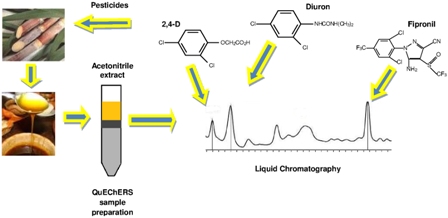
The continuous and indiscriminate use of pesticides facilitates its occurrence in sugarcane derivatives. This work describes a method for determination of pesticides belonging to different chemical classes in sugarcane honey employing the QuEChERS method for extraction and quantification by liquid chromatography
https://dx.doi.org/10.1590/S0103-50532012000200002
J. Braz. Chem. Soc. 2012, 23(2), 206-211
Biotic and Abiotic Stress-Induced Phenylpropanoids in Leaves of the Mango (Mangifera indica L., Anacardiaceae)
Rodolfo R. da Silva; Cláudio A. G. da Câmara; Argus V. Almeida; Clécio S. Ramos
How to cite this article

It was observed that mango leaves emit myristicin, dillapiole, eugenol and eugenol acetate phenylpropanoids as a response to abiotic and biotic stresses. This present investigation contributes to the discovery of new natural insecticides
https://dx.doi.org/10.1590/S0103-50532012000200003
J. Braz. Chem. Soc. 2012, 23(2), 212-219
Refining of Buriti Oil (Mauritia flexuosa) Originated from the Brazilian Cerrado: Physicochemical, Thermal-Oxidative and Nutritional Implications
Jailane de Souza Aquino; Débora C. N. de Pontes Pessoa; Kassandra de Lourdes G. V. Araújo; Poliana S. Epaminondas; Alexandre Ricardo P. Schuler; Antônio G. de Souza; Tânia Lúcia M. Stamford
How to cite this article

This figure shows the steps of the refining of buriti oil (Mauritia flexuosa)
https://dx.doi.org/10.1590/S0103-50532012000200004
J. Braz. Chem. Soc. 2012, 23(2), 220-227
Polymorphism Evaluation in Generic Tablets containing Mebendazole by Dissolution Tests
Sara B. Honorato; Silvia Farfan; Arnaldo Viana; Josué M. Filho; Gisela C. Camarao; Francisco V. Fechine; Maria E. A. Moraes; Manoel O. Moraes; Maribel Ferro; Viviana Dabbene; Silvia L. Cuffini; Alejandro P. Ayala
How to cite this article

This study shows that the low specificity of the USP (United States Pharmacopeia) dissolution conditions for the discrimination of the mebendazole polymorphs gives rise to the widespread different crystal forms in generic tablets. In addition, it was verified that polymorphs A and C exhibit different behaviors in the investigated dissolution media
https://dx.doi.org/10.1590/S0103-50532012000200005
J. Braz. Chem. Soc. 2012, 23(2), 228-235
Dichloroiodoisocyanuric Acid: A New Reagent for Regioselective Coiodination of Alkenes and Iodination of Activated Arenes
Rodrigo da Silva Ribeiro; Pierre M. Esteves; Marcio C. S. de Mattos
How to cite this article

Dichloroiodoisocyanuric acid was prepared in 93% and proved to be very efficient for electrophilic iodination of activated arenes and coiodination of alkene with oxygenated nucleophiles
https://dx.doi.org/10.1590/S0103-50532012000200006
J. Braz. Chem. Soc. 2012, 23(2), 236-240
Photocatalytic Degradation of 1,4-Benzoquinone in Aqueous ZnO Dispersions
Yadollah Abdollahi; Abdul H. Abdullah; Umar I. Gaya; Saeid Ahmadzadeh; Azmi Zakaria; Kamyar Shameli; Zulkarnain Zainal; Hossein Jahangirian; Nor Azah Yusof
How to cite this article
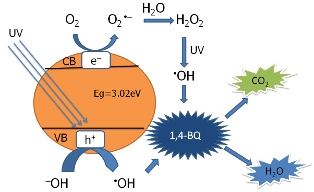
The present paper reports the UV-assisted degradation of 1,4-benzoquinone in ZnO suspensions. In the study, 1,4-benzoquinone photodegradation was independent of pH, the photoactivity of ZnO was maximum at 1.0 g L-1 concentration and particularly at 100 mg L-1 1,4-benzoquinone levels. Within pH 4-10 more than 80% of 1,4-benzoquinone can be removed
https://dx.doi.org/10.1590/S0103-50532012000200007
J. Braz. Chem. Soc. 2012, 23(2), 241-246
Impact of Some Natural Derivatives on the Oxidative Stability of Soybean Oil Based Biodiesel
Min Luo; Ren-Yu Zhang; Zhi Zheng; Jian-li Wang; Jian-Bing Ji
How to cite this article

This f igure indicates that some of the natural antioxidants can significantly improve the oxidation stability of soybean based biodiesel, even better than synthetic antioxidants
https://dx.doi.org/10.1590/S0103-50532012000200008
J. Braz. Chem. Soc. 2012, 23(2), 247-257
Evaluation of the Catalyzed Photo-Cold Vapour Generation for Determination of Mercury by AAS
Henryk Matusiewicz; Ewa Stanisz
How to cite this article

Nano-Ag particles loaded on TiO2 (Ag-TiO2), unmodified TiO2 and ZnO were used as catalysts for the UV-induced cold vapour generation with formic acid coupled to atomic absorption for determination of total mercury in analytical samples
https://dx.doi.org/10.1590/S0103-50532012000200009
J. Braz. Chem. Soc. 2012, 23(2), 258-266
Pd Complexes Based on Phosphine-Linked Cyclophosphazenes: Synthesis, Characterization and Application in Suzuki Coupling Reactions
Vanderlei I. de Paula; Cintia A. Sato; Regina Buffon
How to cite this article

Palladium complexes based on cyclophosphazene-based ligands were tested in Suzuki coupling reactions. Complex N3P3(O-C6H4-p-PCy2)6/Pd3(dba)proved to be robust (could be kept in solution, at room temperature, for at least one week) and could be used in low loadings, affording turnover numbers as high as ca. 17,500 for the coupling of 2-bromotoluene with chlorophenylboronic acid
https://dx.doi.org/10.1590/S0103-50532012000200010
J. Braz. Chem. Soc. 2012, 23(2), 267-272
Multivariate Optimization of Pressurized Solvent Extraction of Alkylphenols and Alkylphenol Ethoxylates from Biosolids
Adolfo Maricán; Inés Ahumada; Pablo Richter
How to cite this article

Quantitative extraction of alkylphenols (APs) and alkylphenol ethoxylates (APEs) from biosolids using pressurized solvent extraction (PSE) was optimized by central composite design, considering the variables: temperature, time and extraction solvent. After optimization, the following optimal values were obtained: 129 ºC, 38 min in 2 cycles and acetone as extraction solvent
https://dx.doi.org/10.1590/S0103-50532012000200011
J. Braz. Chem. Soc. 2012, 23(2), 273-279
Discrimination of Sugarcane according to Cultivar by 1H NMR and Chemometric Analyses
Elenilson G. Alves Filho; Lorena M. A. Silva; Rafael Choze; Luciano M. Lião; Neli K. Honda; Glaucia B. Alcantara
How to cite this article

Sugarcane leaves were analysed by 1H nuclear magnetic resonance spectroscopy and chemometrics. Different cultivars were discriminated by this methodology according to sugar content, especially sucrose and glucose
https://dx.doi.org/10.1590/S0103-50532012000200012
J. Braz. Chem. Soc. 2012, 23(2), 280-284
Total Synthesis of 1-Hydroxydehydroherbarin and Ascomycones A, B, Naphthoquinone Antibiotics
Wen-Kai Dong; Xiong Huang; Dong-Cheng Xu; Xin-Sheng Li; Jian-Wu Xie
How to cite this article

The first total synthesis of 1-hydroxydehydroherbarin and ascomycones A, B is reported. The biologically interesting ascomycones A, B were obtained in 18% overall yield starting from 3-chloro-2,5-dimethoxybenzaldehyde (10) as building block
https://dx.doi.org/10.1590/S0103-50532012000200013
J. Braz. Chem. Soc. 2012, 23(2), 285-293
Diastereoselective Synthesis of Substituted 2-Amino-1,3-propanediols from Morita-Baylis-Hillman Adducts
Paulo H. S. Paioti; Patrícia Rezende; Fernando Coelho
How to cite this article

A diastereoselective approach for the synthesis of 2-amino-1,3-propanediols from Morita-Baylis-Hillman is disclosed herein. The method is based on an ozonolysis reaction to provide 2-oxo-1,3- propanediol derivatives which were used in a reductive amination step
https://dx.doi.org/10.1590/S0103-50532012000200014
J. Braz. Chem. Soc. 2012, 23(2), 294-300
Influence of Tomato Components in the Quantification of Four Pesticides by Gas Chromatography
Gevany P. Pinho; Antônio A. Neves; Maria Eliana L. R. Queiroz; Flaviano O. Silvério; Deyse B. Marthe
How to cite this article

The matrix effect in gas chromatographic analysis is attributed to the presence of coextractives in the organic phase obtained in the extraction process. This work reveals that the internal standard method reduces but does not eliminate this effect
https://dx.doi.org/10.1590/S0103-50532012000200015
J. Braz. Chem. Soc. 2012, 23(2), 301-305
Furanoflavones and other Chemical Constituents of Lonchocarpus obtusos
Maria Gilvânia B. Cavalcante; Rochanne M. Silva; Paulo N. Bandeira; Hélcio S. dos Santos; Otília Deusdênia L. Pessoa; Raimundo Braz-Filho; Maria Rose Jane R. Albuquerque
How to cite this article
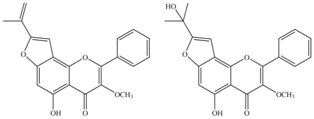
Two new furanoflavonoids (5-hydroxy-2''-isopropenyl-3-methoxyfurane-(2",3":7,8)-flavone and 5-hydroxy-2''-(1-hydroxy-1-methylethyl)-3-methoxyfurane-(2",3":7,8)-flavone) together with twelve known flavonoids and one triterpene were isolated from Lonchocarpus obtusos
https://dx.doi.org/10.1590/S0103-50532012000200016
J. Braz. Chem. Soc. 2012, 23(2), 306-314
Comparison between GC-MS-SIM and GC-ECD for the Determination of Residues of Organochlorine and Organophosphorus Pesticides in Brazilian Citrus Essential Oils
Andréa A. R. Alves; Michelle J. C. Rezende; Ana M. C. Hovell; Humberto R. Bizzo; Ana Carolina L. Oliveira; Silvana V. Rodrigues; Claudia M. Rezende
How to cite this article

Two gas chromatographic methods (gas chromatography-mass spectrometry in selective ion monitoring mode (GC-MS-SIM) and gas chromatography-electron capture detector (GC-ECD) were developed, validated and compared for the determination of residues of organochlorine and organophosphoruspesticides in Brazilian citrus essential oils (EOs). Solid phase extraction (SPE) was used for pre-concentration of pesticides. The analysis of fifteen Brazilian commercial EOs showed that 40% (six samples) presented contamination above the allowed maximum residue limit (MRL)
https://dx.doi.org/10.1590/S0103-50532012000200017
J. Braz. Chem. Soc. 2012, 23(2), 315-321
Characterization of Paracetamol Binding with Normal and Glycated Human Serum Albumin Assayed by a New Electrochemical Method
Parandis Daneshegar; Ali Akbar Moosavi-Movahedi; Parviz Norouzi; Mohammad Reza Ganjali; Mohammad Farhadi; Nader Sheibani
How to cite this article
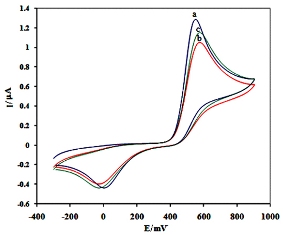
In the present study the interactions between paracetamol (PC) and human serum albumin, in non-glycated (HSA) and glycated form (GHSA), were investigated using continuous cyclic voltammetry in acetate buffer pH 7.4. at the figure the cyclic voltamogram of PC alone(a) after adding the protein has been shown (b,c)
https://dx.doi.org/10.1590/S0103-50532012000200018
J. Braz. Chem. Soc. 2012, 23(2), 322-327
A Catalytic Kinetic Spectrophotometric Determination of Organophosphorus Pesticides in Vegetable Samples
Neetu Tiwari; Anupama Asthana
How to cite this article
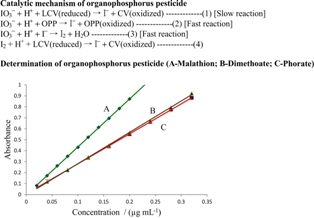
A sensitive kinetic method based on catalytic effect of organophosphorus pesticides malathion(A), dimethoate(B) and phorate(C)) on the oxidation of LCV (leuco crystal violet) by potassium iodate in hydrochloric acid medium to give a violet colored dye. The catalytic activity is mainly exhibited by thiophosphoryl compounds and depends on the nature of the P=S bond
https://dx.doi.org/10.1590/S0103-50532012000200019
J. Braz. Chem. Soc. 2012, 23(2), 328-334
Characterisation of Electrodeposited and Heat-Treated Ni-Mo-P Coatings
Régis L. Melo; Paulo N. S. Casciano; Adriana N. Correia; Pedro de Lima-Neto
How to cite this article
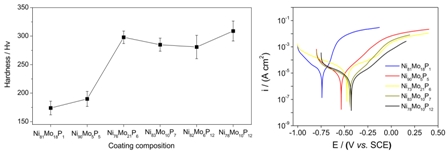
The graphical abstract shows the influence of the P content on hardness and on the corrosion resistance of the electrodeposited Ni-Mo-P. The results show that the addition of P is beneficial for the hardness and corrosion resistance properties of the Ni-Mo-based coatings and the Ni78Mo10P12 sample presented the best hardness and corrosion-resistance properties
https://dx.doi.org/10.1590/S0103-50532012000200020
J. Braz. Chem. Soc. 2012, 23(2), 335-343
Systematic UPLC-ESI-MS/MS Study on the Occurrence of Staurosporine and Derivatives in Associated Marine Microorganisms from Eudistoma vannamei
Márcio A. Andréo; Paula C. Jimenez; Josy B. C. N. Siebra; Leticia V. Costa-Lotufo; Ricardo Vessecchi; Michael Niehues; João L. C. Lopes; Norberto P. Lopes
How to cite this article

Marine microorganisms from Eudistoma vannamei presenting Streptomyces sp. able to generate staurosporine with significant cytotoxic activity against human cancer lines
https://dx.doi.org/10.1590/S0103-50532012000200021
Short Reports J. Braz. Chem. Soc. 2012, 23(2), 344-348
Synthesis of the C1-C9 Fragment of the Potent Antitumor Agent Dictyostatin
Luiz C. Dias; Danilo P. Sant' Ana; Ygor W. Vieira; Caroline C. S. Gonçalves; Dimas J. P. Lima
How to cite this article

A short and efficient approach to the C1-C9 fragment of the potent antitumor agent dictyostatin is described
https://dx.doi.org/10.1590/S0103-50532012000200022
J. Braz. Chem. Soc. 2012, 23(2), 349-354
Lycopodium Alkaloids from Palhinhaea cernua
Fu-Wei Zhao; Qian-Yun Sun; Fu-Mei Yang; Ji-Feng Luo; Guang-Wan Hu; Fang Liu; Yue-Hu Wang; Chun-Lin Long
How to cite this article

Two new Lycopodium alkaloids, acetyllycoserramine M and palcermine A, were isolated from Palhinhaea cernua L. Their structures were elucidated by spectroscopic methods and single-crystal X-ray diffraction analyses
https://dx.doi.org/10.1590/S0103-50532012000200023
J. Braz. Chem. Soc. 2012, 23(2), 355-360
Antiprotozoal Alkaloids from Psychotria prunifolia (Kunth) Steyerm
Lucilia Kato; Cecília M. A. de Oliveira; Emiret O. Faria; Laryssa C. Ribeiro; Brenda G. Carvalho; Cleuza C. da Silva; Ivânia T. A. Schuquel; Silvana M. O. Santin; Celso V. Nakamura; Elisandra A. Britta; Nathielle Miranda; Amadeu H. Iglesias; Piero G. Delprete
How to cite this article

Two new alkaloids were isolated from P. prunifolia besides the known alkaloids. Two known compounds exhibited in vitro inhibitory activity against Leishmania amazonensis with IC50 values of 16.0 and 40.7 μgg per mL
https://dx.doi.org/10.1590/S0103-50532012000200024
J. Braz. Chem. Soc. 2012, 23(2), 361-366
Caavuranamide, a Novel Steroidal Alkaloid from the Ripe Fruits of Solanum caavurana Vell. (Solanaceae)
Nelissa Pacheco Vaz; Emmanoel V. Costa; Érica L. Santos; Sandra Bos Mikich; Francisco A. Marques; Raquel M. Braga; Camila Delarmelina; Marta C. T. Duarte; Ana Lúcia T. G. Ruiz; Vanessa H. S. Souza; João E. de Carvalho; Beatriz H. L. N. Sales Maia
How to cite this article

Solanum steroidal alkaloids occur almost exclusively with 3β-OH and are commonly found in its glycosylated form. On the other hand, there is only one report of a 3β-N-formyl substituent with a solanidane-type skeleton. Caavuranamide (from S. caavurana Vell.) is the second report of an N-formyl steroidal alkaloid in this genus, and the first with a spirosolane-type skeleton
https://dx.doi.org/10.1590/S0103-50532012000200025
J. Braz. Chem. Soc. 2012, 23(2), 367-371
Impact of Chemical Oxidation on Brazilian Soils
Leandro A. da Silva; Silvio C. G. Teixeira; Daniel V. Pérez; Mônica R. da C. Marques
How to cite this article

Clay soils have been degraded after treatment by Fenton's reagent, decreasing its cation exchange capacity (CEC), which may cause long-term soil infertility because of reduced capacity to retain water and nutrients
https://dx.doi.org/10.1590/S0103-50532012000200026
Online version ISSN 1678-4790 Printed version ISSN 0103-5053
Journal of the Brazilian Chemical Society
JBCS Editorial and Publishing Office
University of Campinas - UNICAMP
13083-970 Campinas-SP, Brazil
Free access










